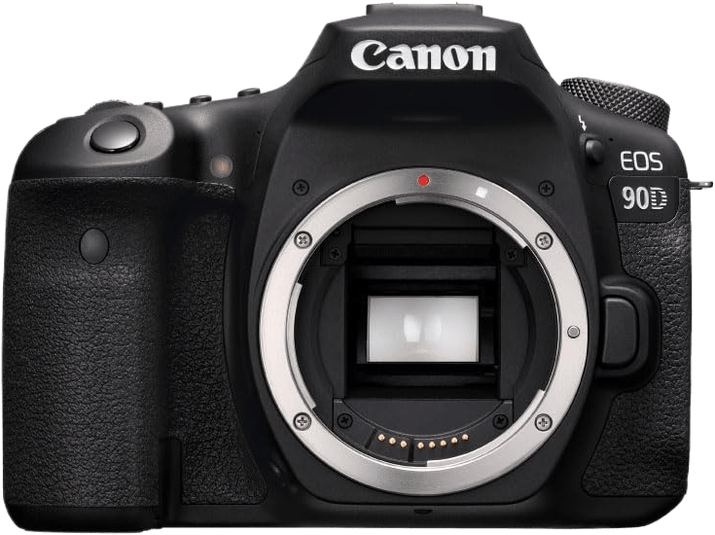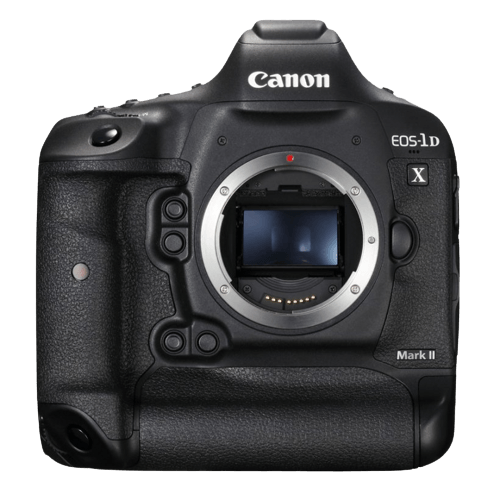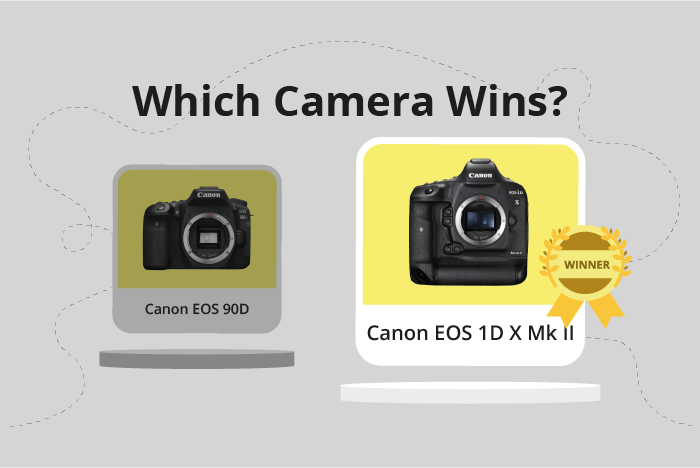Canon EOS 90D vs EOS 1D X Mark II Comparison
Canon EOS 90D

Canon EOS 1D X Mark II

The Canon EOS 1D X Mark II outperforms the Canon EOS 90D with a score of 73/100, compared to the 90D’s 67/100. Both cameras are DSLRs released by Canon, with the 1D X Mark II launched in 2016 and the 90D in 2019. They share similar specifications, but there are key differences that set them apart.
The 1D X Mark II excels with its larger size (158 x 168 x 83mm) and heavier weight (1530g), providing a more robust and professional feel. However, the 90D is more affordable with a launch price of $1199, significantly lower than the 1D X Mark II’s $6000 price tag. Additionally, the 90D’s smaller size (141 x 105 x 77mm) and lighter weight (701g) make it more portable and user-friendly.
Considering these factors, the Canon EOS 1D X Mark II is the superior camera due to its higher score, but the Canon EOS 90D offers a more budget-friendly and compact option for photographers.
Canon EOS 90D vs EOS 1D X Mark II Overview and Optics
The Canon EOS 1D X Mark II surpasses the Canon EOS 90D in optics with a score of 72/100 compared to the 90D’s score of 62/100. Both cameras share similarities in their specifications, including the CMOS sensor type, Canon EF lens mount, and lack of image stabilization.
The 1D X Mark II’s superiority in optics stems from its higher DXOMARK sensor score of 88 and a full-frame sensor size. These features contribute to better image quality and low-light performance. Additionally, the 1D X Mark II has a faster shooting speed of 16 frames per second (fps), allowing for improved action and sports photography.
On the other hand, the EOS 90D has a higher megapixel count of 33, which can result in more detailed images. However, this advantage is offset by the camera’s lower DXOMARK sensor score of 58 and smaller APS-C sensor size. The 90D’s shooting speed of 10 fps is slower compared to the 1D X Mark II, but still adequate for most photography needs. Both cameras use different processors, with the 90D utilizing the newer Digic 8, while the 1D X Mark II relies on the dual Digic 6+.
In terms of optics, the Canon EOS 1D X Mark II emerges as the stronger contender due to its superior sensor score, full-frame sensor size, and faster shooting speed. While the Canon EOS 90D offers a higher megapixel count, it falls short in other key aspects that contribute to overall image quality. Photographers seeking optimal performance in optics should opt for the Canon EOS 1D X Mark II, while those prioritizing higher resolution might find the Canon EOS 90D more suitable for their needs.
Canon EOS 90D vs EOS 1D X Mark II Video Performance
The Canon EOS 90D outperforms the Canon EOS 1D X Mark II in video capabilities, scoring 91/100 compared to the latter’s 69/100. Both cameras share the ability to record in 4K resolution, with the 90D having a maximum video dimension of 3840 x 2160 and the 1D X Mark II at 4096 x 2160.
The 90D surpasses the 1D X Mark II with its higher maximum video frame rate of 120fps, double that of the 1D X Mark II’s 60fps. This advantage allows the 90D to capture smoother slow-motion footage and provide more flexibility in post-production. Additionally, the 90D includes built-in time-lapse functionality, making it more versatile for creative video projects without requiring extra equipment or software.
The 1D X Mark II, however, excels with its slightly larger maximum video dimensions. This difference can result in marginally more detailed footage, although the impact on overall video quality is minimal. The 1D X Mark II’s advantage in this aspect does not outweigh the benefits offered by the 90D’s higher frame rate and time-lapse feature.
Considering the video capabilities of both cameras, the Canon EOS 90D proves to be the better choice due to its superior frame rate and built-in time-lapse functionality. While the 1D X Mark II has a slight edge in maximum video dimensions, this advantage is not significant enough to compensate for the 90D’s higher video score and additional features. Therefore, the Canon EOS 90D is the recommended camera for users seeking enhanced video performance.
Canon EOS 90D vs EOS 1D X Mark II Features and Benefits
The Canon EOS 90D outperforms the Canon EOS 1D X Mark II in terms of features, scoring 83/100 compared to the latter’s 74/100. Both cameras share some similarities, such as screen size, touchscreen functionality, and screen resolution. The EOS 90D has a 3-inch screen, while the EOS 1D X Mark II has a slightly larger 3.2-inch screen. Both cameras also have touchscreens, with the EOS 90D having a screen resolution of 1,040,000 dots and the EOS 1D X Mark II having a higher resolution of 1,620,000 dots.
The EOS 90D takes the lead with additional features such as a flip screen, Wi-Fi, and Bluetooth capabilities. The flip screen allows for more versatile shooting angles, while Wi-Fi and Bluetooth make it easier to transfer files and control the camera remotely. These features make the EOS 90D more user-friendly and adaptable to different shooting situations.
On the other hand, the EOS 1D X Mark II has GPS functionality, which the EOS 90D lacks. This feature allows for geotagging photos, which can be useful for travel photography and documentation purposes. However, this advantage is not enough to surpass the EOS 90D’s overall higher feature score.
Taking these points into consideration, the Canon EOS 90D emerges as the better camera in terms of features, offering a wider range of functionalities that cater to different photography needs. The EOS 1D X Mark II’s GPS feature is noteworthy, but it cannot compensate for the absence of Wi-Fi, Bluetooth, and a flip screen. Thus, the EOS 90D’s superior feature set makes it a more versatile and practical choice for photographers.
Canon EOS 90D vs EOS 1D X Mark II Storage and Battery
The Canon EOS 1D X Mark II outperforms the Canon EOS 90D in storage and battery with a score of 79/100, compared to the 90D’s 48/100. Both cameras lack USB charging capabilities, but the 1D X Mark II excels with two memory card slots accepting Compact Flash and CFast 2.0 cards. This provides more storage flexibility and backup options. The 90D, on the other hand, has only one memory card slot compatible with SD, SDHC, and SDXC (UHS-II) cards.
Regarding battery life, the EOS 90D takes the lead with 1300 shots per charge, using an LP-E6N battery, while the 1D X Mark II offers 1210 shots with its LP-E19 battery. Although the 90D has a slightly longer battery life, the 1D X Mark II’s superior storage capabilities make it the better choice in this comparison.
Thus, the Canon EOS 1D X Mark II proves to be the superior camera in terms of storage and battery, thanks to its dual memory card slots and versatile storage options. The Canon EOS 90D, however, provides a marginally longer battery life, which may be advantageous for some users.
Canon EOS 90D vs EOS 1D X Mark II – Our Verdict
Are you still undecided about which camera is right for you? Have a look at these popular comparisons that feature the Canon EOS 90D or the Canon EOS 1D X Mark II:

